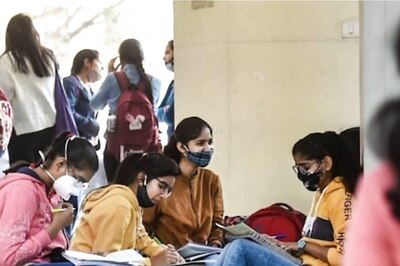
views
Deaths due to stroke are expected to increase to 10 million annually by 2050, according to a grim forecast by the Lancet Neurology Commission. It predicts a staggering 50% surge in deaths due to stroke.
The commission said that the deaths will soar from 6.6 million in 2020 to 9.7 million by 2050, with the major burden on low and middle-income countries (LMICs).
Stroke is the second leading cause of death worldwide and the burden of disability after a stroke is also large.
This projection comes from the collaborative effort of the World Stroke Organization and the Lancet Neurology Commission under which four studies have been published.
“In this commission, we forecast the burden of stroke from 2020 to 2050. We project that stroke mortality will increase by 50% — from 6.6 million in 2020 to 9.7 million in 2050 — with disability-adjusted life-years (DALYs) growing over the same period from 144.8 million in 2020 to 189.3 million in 2050,” the report published in The Lancet Neurology Commission on October 9 said.
Pointing towards an alarming trend globally, the incidence of stroke is increasing in young and middle-aged people aged less than 55 years.
“Should these trends continue, Sustainable Development Goal 3.4 (reducing the burden of stroke as part of the general target to reduce the burden of non-communicable diseases by a third by 2030) will not be met,” the report said.
Multiple factors contribute to the high burden of stroke in low-income and middle-income countries, including undetected and uncontrolled hypertension, air pollution, unhealthy lifestyles (poor diet, smoking, sedentary lifestyle, obesity) and the burden of infectious diseases.
The projections show that the absolute number of people who will die from stroke and will get disability due to stroke will continue to increase until 2050. However, the pace of the overall increase in the stroke burden from 2020 to 2050 is slower than that from 1990–2019.
Burden of Stroke Higher in LMICs
According to the report, most of the contemporary stroke burden — 86% of global deaths and 89% of global DALYs lost because of stroke in 2020 — is in low-income and middle-income countries (LMICs).
By 2050, it is estimated that the contribution of stroke deaths in LMICs will see an increase from 86% to 91%. It also said that the burden of stroke is increasing faster in LMICs than in high-income countries (HICs). India also falls under LMICs.
“The absolute number of people affected by stroke, which includes those who die or remain disabled, has almost doubled in the past 30 years.”
Stroke is also a leading cause of depression and dementia, which are other common non-communicable diseases (NCDs).
According to the study, given that the incidence of stroke rises with age, the combination of growing populations and ageing demographics is likely to result in large increases in global deaths and disability in the future unless major improvements occur in population prevention programmes that reduce the risk of stroke.
Intracerebral Haemorrhage
The commission has predicted that an increasing proportion of stroke deaths globally would be caused by intracerebral haemorrhage.
“This increase is largely attributable to the proportional increase of deaths from intracerebral haemorrhages in LMICs (from 2.7 million in 2020 to 4.8 million in 2050), especially among people aged 60 years or older.”
Intracerebral haemorrhage is when there’s bleeding inside the brain. It happens when a small blood vessel in the brain bursts, causing blood to leak into the brain tissues. This can damage the brain and can be a fatal condition.
Also, the proportion of intracerebral haemorrhage in LMICs countries in 2050 is projected to be 1.5 times greater than that in higher-income countries (HICs), probably because of the higher prevalence and poorer control of hypertension in LMICs.
“Deaths from intracerebral haemorrhage among people younger than 60 years are projected to decrease in HICs… probably because of better control of hypertension.”
The findings also suggest an increase (compared with 1990–2019) in the contribution of intracerebral haemorrhage to the overall increase in stroke burden in the world, especially in Southeast Asia, east Asia, and Oceania.
“However, the fastest growth in deaths from intracerebral haemorrhage in 2050 is projected to occur in sub-Saharan Africa. The main risk factor for stroke — and particularly for intracerebral haemorrhage — is hypertension, and thus our projections support a call for improving prevention and treatment of hypertension.”
India to Deploy Evidence-Based Stroke Care: ICMR
According to India’s apex medical research body, the Indian Council of Medical Research (ICMR), this report has emphasised the critical role of evidence-based, pragmatic solutions in combating this looming crisis.
“Implementing and rigorously monitoring the commission’s recommendations, which are firmly grounded in evidence, could lead to a significant reduction in the global stroke burden, effectively countering this ominous projection,” ICMR said in a press release.
Dr Rajiv Bahl, Director General, ICMR, stressed the importance of implementing evidence-based stroke care to mitigate disability and prevent new strokes.
“The Government of India is committed to formulating evidence-based policies and their implementation through the National Programme for Prevention & Control of Non-Communicable Diseases (NP-NCD),” the release said, also mentioning the success of India’s Hypertension Control Initiative (IHCI), which employed tech-driven innovations to digitally monitor over 2 million patients, achieving real-time blood pressure control in 50% of cases.



















Comments
0 comment